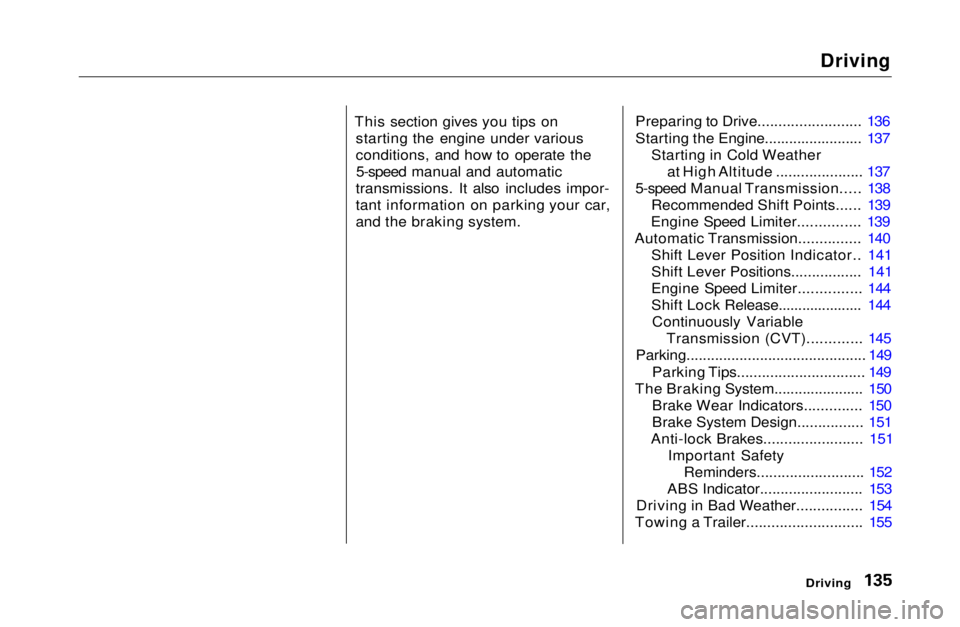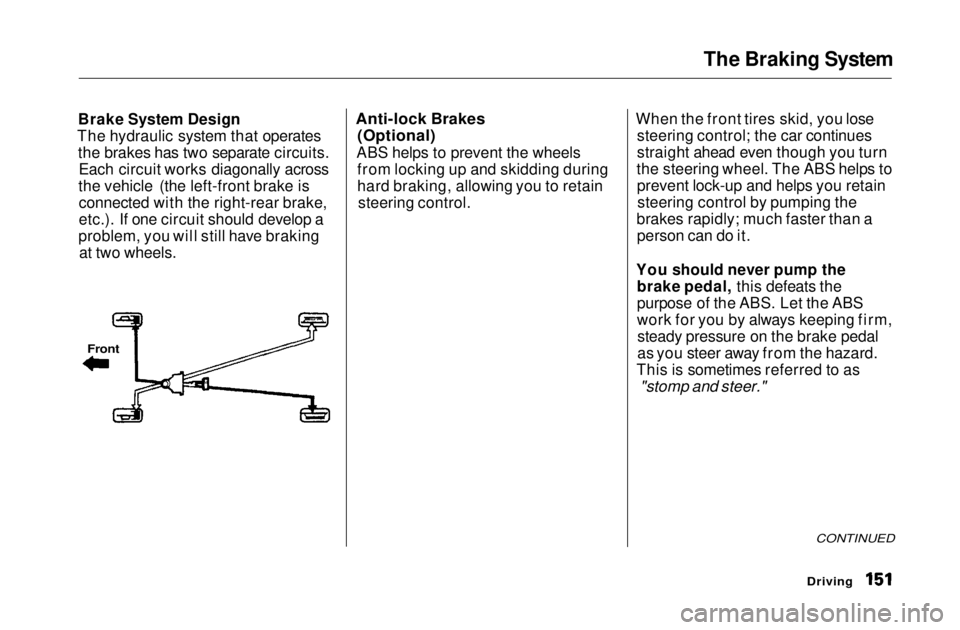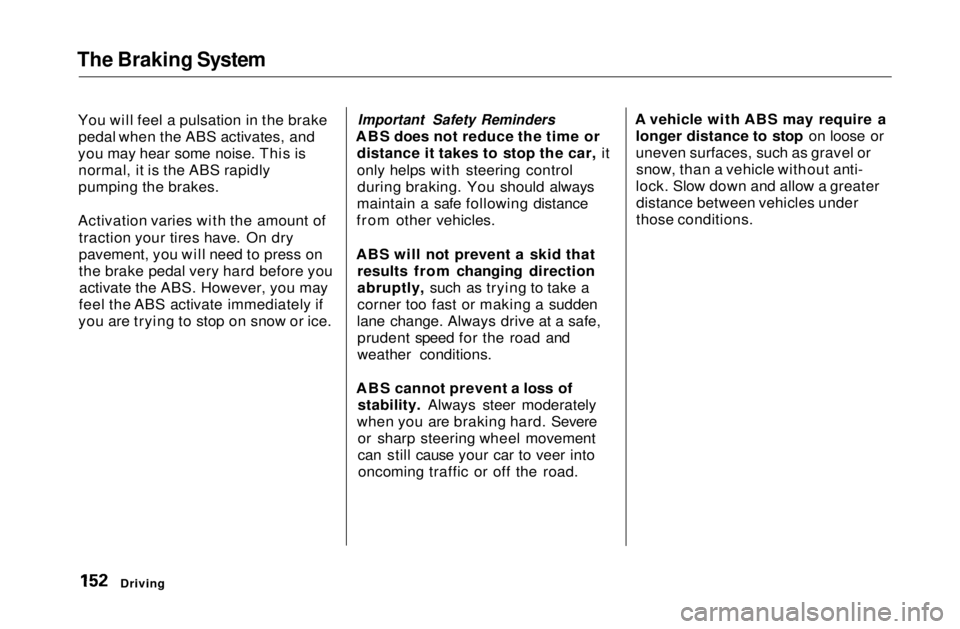Page 8 of 269
Your Car's Safety Features
Your car is equipped with many features that work together to
protect you and your passengersduring a crash.
Some safety features do not require
any action on your part. These
include a strong steel framework
that forms a safety cage around the
passenger compartment; front and rear crush zones that are designed to
crumple and absorb energy during a
crash; and a collapsible steering
column.
These safety features are designed to reduce the severity of injuries in a
crash. However, you and your
passengers can't take full advantageof these safety features unless you
remain sitting in a proper position
and always wear your seat belts
properly. In fact, some safety
features can contribute to injuries if they are not used properly.
Driver and Passenger Safety
(1) Safety Cage
(2) Crush Zones
(3) Seats & Seats-Backs
(4) Head Restraints
(5) Collapsible Steering Column
(6) Seat Belts
(7) Airbags
(8) Door LocksMain Menu Table of Contents s t
Page 11 of 269

Your Car's Safety Features
Seats & Seat-Backs
Your car's seats are designed to keep
you in a comfortable, upright position so you can take full
advantage of the protection offered
by seat belts and the energy absorbing materials in the seats.
How you adjust your seats and seat-
backs can also affect your safety. For example, sitting too close to thesteering wheel or dashboard
increases the risk of you or your
passenger being injured by striking
the inside of the car, or by an
inflating airbag.
Reclining a seat-back too far reduces
the seat belt's effectiveness and increases the chance that the seat's
occupant will slide under the seat
belt in a crash and be seriously
injured.
What you should do: Move the front
seats as far back as possible, and
keep adjustable seat-backs in an
upright position whenever the car is
moving.
Head Restraints
Head restraints can help protect you
from whiplash and other injuries. For maximum protection, the back of
your head should rest against the center of the head restraint.
Driver and Passenger SafetyMain Menu Table of Contents s t
Page 56 of 269

Indicator Lights
Charging System
Indicator
If this light comes on when the
engine is running, the battery is not
being charged. For complete
information, see page 232.
Low Oil Pressure
Indicator
The engine can be severely damaged
if this light flashes or stays on when
the engine is running. For complete
information, see page 232.
High Beam Indicator
This light comes on with the high beam headlights. See page 61 for
information on the headlight
controls.
On Canadian models, this indicator
comes on with reduced brightness
when the Daytime Running Lights (DRL) are on (see page 61). Parking Brake
and Brake
System
Indicator
This light has two functions:
1. It lights as a reminder that you have not released the parking
brake. Driving with the parking
brake applied can damage the
brakes and tires.
2. If it remains lit after you release the parking brake while the engineis running, or comes on while
driving, it can indicate a problem
in the brake system. For complete information, see page 234 .
Malfunction Indicator
Lamp
See page 233.
Anti-lock Brake
System (ABS)Indicator
Only on cars equipped with ABS (see
page 153)
This light normally comes on for a few seconds when you turn theignition switch ON (II), and when
the ignition switch is turned to START (III). If this light comes on at
any other time, there is a problem in
the ABS. If this happens, take the car to your dealer to have it checked.
With the light on, your car still has normal braking ability but no anti-
lock.
Instruments and Controls
U.S.
Canada
BRAKE
ABS
U.S.
CanadaMain Menu Table of Contents s t
Page 135 of 269

Driving
This section gives you tips on starting the engine under various
conditions, and how to operate the5-speed manual and automatic
transmissions. It also includes impor-
tant information on parking your car,
and the braking system. Preparing to Drive......................... 136
Starting the Engine........................ 137
Starting in Cold Weatherat High Altitude ..................... 137
5-speed Manual Transmission..... 138 Recommended Shift Points...... 139
Engine Speed Limiter............... 139
Automatic Transmission............... 140 Shift Lever Position Indicator.. 141
Shift Lever Positions................. 141
Engine Speed Limiter............... 144
Shift Lock Release..................... 144Continuously Variable Transmission (CVT)............. 145
Parking............................................ 149
Parking Tips............................... 149
The Braking System...................... 150 Brake Wear Indicators.............. 150
Brake System Design................ 151
Anti-lock Brakes........................ 151 Important SafetyReminders.......................... 152
ABS Indicator......................... 153
Driving in Bad Weather................ 154
Towing a Trailer............................ 155
DrivingMain Menu s t
Page 151 of 269

The Braking System
Brake System Design
The hydraulic system that operates the brakes has two separate circuits.Each circuit works diagonally across
the vehicle (the left-front brake is connected with the right-rear brake,
etc.). If one circuit should develop a
problem, you will still have braking at two wheels.
Anti-lock Brakes
(Optional)
ABS helps to prevent the wheels from locking up and skidding during
hard braking, allowing you to retainsteering control. When the front tires skid, you lose
steering control; the car continues
straight ahead even though you turn
the steering wheel. The ABS helps to prevent lock-up and helps you retainsteering control by pumping the
brakes rapidly; much faster than a person can do it.
You should never pump the brake pedal, this defeats the
purpose of the ABS. Let the ABS
work for you by always keeping firm,steady pressure on the brake pedal
as you steer away from the hazard.
This is sometimes referred to as
"stomp and steer."
CONTINUED
Driving
FrontMain Menu Table of Contents s t
Page 152 of 269

The Braking System
You will feel a pulsation in the brakepedal when the ABS activates, and
you may hear some noise. This is normal, it is the ABS rapidly
pumping the brakes.
Activation varies with the amount of traction your tires have. On dry
pavement, you will need to press on
the brake pedal very hard before youactivate the ABS. However, you may
feel the ABS activate immediately if
you are trying to stop on snow or ice.
Important Safety Reminders
ABS does not reduce the time or distance it takes to stop the car, it
only helps with steering controlduring braking. You should always
maintain a safe following distance
from other vehicles.
ABS will not prevent a skid that results from changing direction
abruptly, such as trying to take a
corner too fast or making a sudden
lane change. Always drive at a safe, prudent speed for the road and
weather conditions.
ABS cannot prevent a loss of stability. Always steer moderately
when you are braking hard. Severe or sharp steering wheel movement
can still cause your car to veer intooncoming traffic or off the road. A vehicle with ABS may require a
longer distance to stop on loose or
uneven surfaces, such as gravel orsnow, than a vehicle without anti-
lock. Slow down and allow a greater distance between vehicles under
those conditions.
DrivingMain Menu Table of Contents s t
Page 153 of 269
The Braking System
*U.S. indicator shown
The ABS is self-checking. It also checks itself whenever you use the
brakes.
If anything goes wrong, the ABS
indicator on the instrument panelcomes on (see page 55). This means
the anti-lock function of the braking system has shut down. The brakes
still work like a conventional system
without anti-lock, providing normal stopping ability. You should have the dealer inspect your car as soon as
possible if this light stays on after
you start the engine, or comes on
while driving.
Driving
ABS Indicator
ABS INDICATOR'Main Menu Table of Contents s t
Page 185 of 269
Air Cleaner Element, Hood Latch
Replacement
On HX, EX and Si models in the U.S.,
and Si and SiR models in Canada
The air cleaner element is inside the air cleaner housing on the passenger'sside of the engine compartment.
To replace it:
1. Unsnap the two clips and remove the air cleaner housing cover. 2. Remove the old air cleaner
element.
Carefully clean the inside of the
air cleaner housing with a damp
rag.
3. Place the new air cleaner element in the air cleaner housing.
4. Align the tabs and reinstall the air cleaner housing cover, snap the
two clips back into place. Hood Latch
Clean the hood latch assembly with a
mild cleaner, then lubricate it with a
multipurpose grease. Lubricate all
the moving parts, including the pivot. Follow the time and distance
recommendations in the
Maintenance Schedule. If you are
not sure how to clean and grease the
latch, contact your Honda dealer.
Maintenance
CLIPS
AIR CLEANER
ELEMENT
PIVOTSMain Menu Table of Contents s t